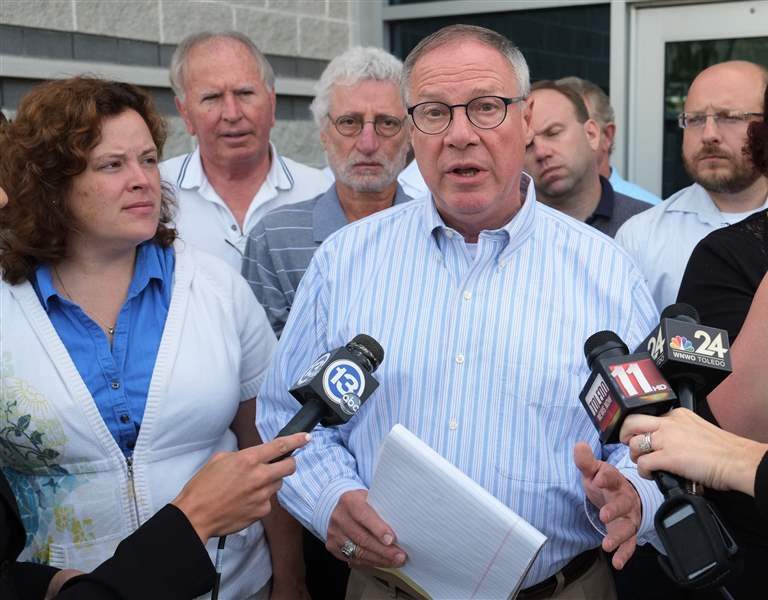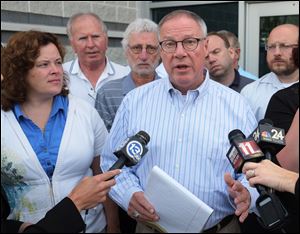
Toledo water test results are improving but region still has a long way, mayor says
8/3/2014
Flanked by city councilman Lindsay Webb, and Lucas County Health Commissioner Dr. David Grossman, Toledo Mayor D. Michael Collins gives an update on water testing during a morning news conference today downtown.
The Blade/Dave Zapotosky
Buy This Image

Flanked by city councilman Lindsay Webb, and Lucas County Health Commissioner Dr. David Grossman, Toledo Mayor D. Michael Collins gives an update on water testing during a morning news conference today downtown.
Toledo Mayor D. Michael Collins said during today's first news briefing that results of water samples are improving, but that the region still has a long way to go before it can safely resume drinking tap water.
"We have some results, but not enough to go by," he told reporters outside the Lucas County Emergency Services Building. "All of the results continue to improve. We have more below detectable levels [of toxic microcystin] than we had before. This is not over yet, though."
He also announced Gov. John Kasich was en route to Toledo to speak with him and other officials. The governor is expected to arrive between 1 and 1:30 p.m., during which time officials will go over the latest results from an Ohio Environmental Protection Agency laboratory in Reynoldsburg, Ohio.
Some - but not all - of those results were in before Mr. Collins and others gave their first news briefing at about 10 a.m.
RELATED:
■ List of area water distribution centers
■ Water crisis grips hundreds of thousands in Toledo area
■ Join the conversation using #emptyGlassCIty
PHOTO GALLERIES:
■ Kasich, Collins comment as Toledo water crisis continues
■ Toledoans still scurrying for water supplies
■ Algae at Toledo water intake crib
Mr. Collins did not share the data, but said officials are comparing that data to what they have received in recent hours from tests performed at Lake Superior State University in Sault Ste. Marie and with the first round of tests from the most highly specialized lab, a U.S. EPA facility in Cincinnati.
A second round of samples sent to that lab were scheduled to arrive in Cincinnati about the same time the news conference began. Results of those are not expected until at least late this afternoon, Mr. Collins said.
Officials are likely to wait on them before acting.
Although Mr. Collins said that "everything is trending in a positive direction" so far, he firmly disputed any notion of telling people it is safe to drink the water again until he and other officials know for sure. Saturday night, he told The Blade he would not endorse a return to normal operations until he is convinced the water is safe enough for him and his family members to drink, as well as all Toledo-area children.
"We're not going to get into a situation where we give false hope," Mr. Collins told reporters at the morning news conference.
He said he hopes the algae bloom that has caused the disruption in drinking service "would not be a continuing problem this summer."
But when asked by a Blade reporter how it can't be - given that the annual algae season has only begun and usually doesn't peak until late September - Mr. Collins said he could offer no assurances.
The first step is getting through this crisis, the first of its kind for Toledo.
He reiterated his desire to have the city push for stronger environmental controls aimed at curbing nutrients such as phosphorus, which help algae grow.
Getting through the crisis at hand "is not going to eliminate the algae problem in western Lake Erie. That is not going to help with the megafarm pollution," he said.
Toledo and Lucas County also released an update on today's water-distribution centers.
Those open today are at Central Catholic High School, Waite High School, Woodward High School, Springfield High School, and the University of Toledo's Scott Park campus.
Residents also can get drinkable water from three Oregon fire stations, and the Village of Whitehouse Fire Department.
A new distribution center has been open, as of 10 a.m., at the Parkway Plaza in Maumee.
Residents are asked to bring their own containers for most of those sites.
Some 33,000 gallons of drinkable water have been provided by the Ohio National Guard, with donations coming from other sources.
Retail stores also are working to restock their shelves with water, according to a joint city-county statement.
Restaurants are asked to remain closed unless they have enough bottled water for cooking, food preparation, and washing dishes.
Contact Tom Henry at: thenry@theblade.com or 419-724-6079 or on Twitter @ecowriterohio.